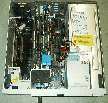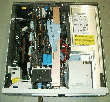IBM RS/6000 320/32H specific notes


The 320/32H are of particular interest to me, since they were
the first RS/6000s which appeared at my workplace, GSI. Introduced by IBM in
early 1990
they were available at GSI soon after as playfields to sneek into UNIX.
Until then, we had only "proprietary" systems such as MVS on S/370 mainframes
and VAX/VMS.
Those early 320s looked more like PCs, in fact they shared the
Microchannel Architecture. They
came with only 8MB or 16MB of RAM,
which was definitely not enough. Especially linking large (for the time)
programs easily could lead to turn around times of about half an hour.
But equipped with enough RAM (32MB was about right and not too expensive)
they were real racing horses which left all of the competition in the dust
for quite some time.
With the usual L&F (==educational) discounts one could purchase
a 32H with 1/2 the raw horsepower of an IBM mainframe's CPU,
but at only 1/20 of the price. Its price/performance ratio also
beat that of the then popular VAXstations by a factor of three or more.
Riding this wave, in 1991 a 32H became my first RS/6000, my first workstation
and my first personal UNIX box altogether. Unfortunately it got scrapped later on
when it became obsolete (in fact I wasn't too much interested in keeping
old stuff back then).
So my current 320 and 32H machines are a reminiscence of those old days.
There's almost no difference, except they are clocked differently, at 20 and 25 MHz,
respectively.
The 320 came rather incomplete (no disk, no network, no internal SCSI cable, and most unfortunate: no key),
so I'll concentrate on the 32H. It had no disks either, but
at least the necessary internal cable.
And it still had the key, which is necessary
not only for opening the case but also for installing the AIX OS.
Pixx

 Unfortunately the case has a little damage at the rear side.
Unfortunately the case has a little damage at the rear side.
 View inside with CPU and RAM removed.
View inside with CPU and RAM removed.
 View inside, working condition.
View inside, working condition.
CPU
 The original POWER CPU was not a sing╬e chip, but comprised a collection
of functional units on one card. Nevertheless it was by far the fastest
workstation CPU when it came out.
The original POWER CPU was not a sing╬e chip, but comprised a collection
of functional units on one card. Nevertheless it was by far the fastest
workstation CPU when it came out.
RAM
 This is the RAM card:
S1, FRU=59F4433, (53F3089/91 if it comes with 8/16MB installed), P/N=41F0521 (?).
holding 8 single RAM modules (ECC, not just parity).
Originally it had 2MB modules (Samsung KMM540512BG-8, 512Kx40-8P, P/N 68x6271).
The S1 maxes out at 32MB, for which 4MB modules are needed,
for example THM401010ASG-80 68x6356.
I also tried
IBM P/N 68x6357 FRU 70F9976, which have 8MB. They work, but only 4MB are recognized.
This is the RAM card:
S1, FRU=59F4433, (53F3089/91 if it comes with 8/16MB installed), P/N=41F0521 (?).
holding 8 single RAM modules (ECC, not just parity).
Originally it had 2MB modules (Samsung KMM540512BG-8, 512Kx40-8P, P/N 68x6271).
The S1 maxes out at 32MB, for which 4MB modules are needed,
for example THM401010ASG-80 68x6356.
I also tried
IBM P/N 68x6357 FRU 70F9976, which have 8MB. They work, but only 4MB are recognized.
Eventually I could spot enough of the 68x6356 modules to max out the S1 board,
and even more, a third party board, the
Cambex P/N 360-028-700 A
gave me a whopping extra 64MB.
SCSI card
SCSI comes on a dedicated MCA board. It has an extra fuse (12.5V/1A) which was missing
in one of the machines, so the board appears to be dead and I had to swap it.
Unfortunately both, the internal and the external connectors are IBM proprietary,
but this wasn't so unusual for the times.
For the internal connection a special cable is needed (see below).
The external connector needs an adapter cable.
SCSI disk
 The disk holder with the special internal cable.
The disk holder with the special internal cable.
The proprietary end connects to
the SCSI card, the other one is standard 50-pin, and any 50-pin SCSI2 disk should work.
In fact the cable has two 50-pin outlets, corresponding to the two disks one can stuff
into the holder. The cable has its own terminator, which makes it a bit difficult
to plug this end into a flat disk's connectors.
Key Mode Secrets
Diagnostic sequence for an 888 code
Press reset once.
Is "102" displayed on LED?
YES --> Software prob. press reset once for crash code,
then again for dump code. Reboot. END
NO --> Continue.
Is "103" or "105" displayed on LED?
YES --> Hardware prob. press reset 2x for SRN code
then again for FRU code
press reset 8x for location code. Reboot. END
Last updated: 30-Dec-2011,
M.Kraemer



 Unfortunately the case has a little damage at the rear side.
Unfortunately the case has a little damage at the rear side.
 View inside with CPU and RAM removed.
View inside with CPU and RAM removed.
 View inside, working condition.
View inside, working condition.
 The original POWER CPU was not a sing╬e chip, but comprised a collection
of functional units on one card. Nevertheless it was by far the fastest
workstation CPU when it came out.
The original POWER CPU was not a sing╬e chip, but comprised a collection
of functional units on one card. Nevertheless it was by far the fastest
workstation CPU when it came out.
 This is the RAM card:
S1, FRU=59F4433, (53F3089/91 if it comes with 8/16MB installed), P/N=41F0521 (?).
holding 8 single RAM modules (ECC, not just parity).
Originally it had 2MB modules (Samsung KMM540512BG-8, 512Kx40-8P, P/N 68x6271).
The S1 maxes out at 32MB, for which 4MB modules are needed,
for example THM401010ASG-80 68x6356.
I also tried
IBM P/N 68x6357 FRU 70F9976, which have 8MB. They work, but only 4MB are recognized.
This is the RAM card:
S1, FRU=59F4433, (53F3089/91 if it comes with 8/16MB installed), P/N=41F0521 (?).
holding 8 single RAM modules (ECC, not just parity).
Originally it had 2MB modules (Samsung KMM540512BG-8, 512Kx40-8P, P/N 68x6271).
The S1 maxes out at 32MB, for which 4MB modules are needed,
for example THM401010ASG-80 68x6356.
I also tried
IBM P/N 68x6357 FRU 70F9976, which have 8MB. They work, but only 4MB are recognized.
 The disk holder with the special internal cable.
The disk holder with the special internal cable.